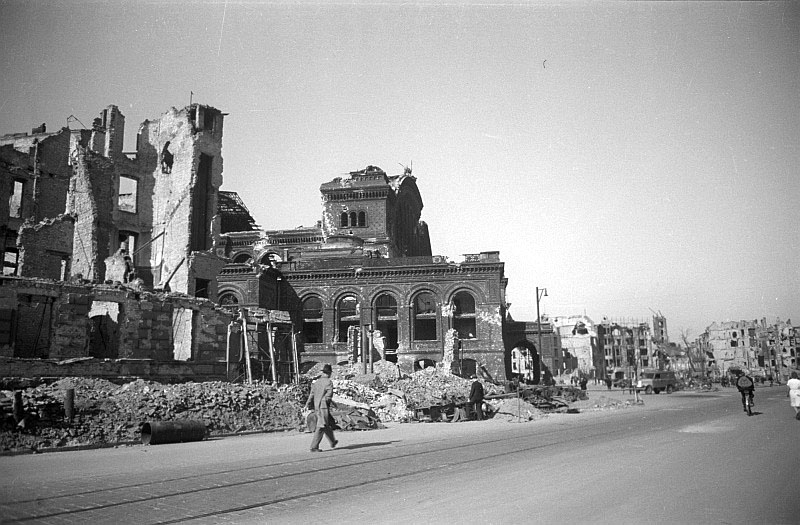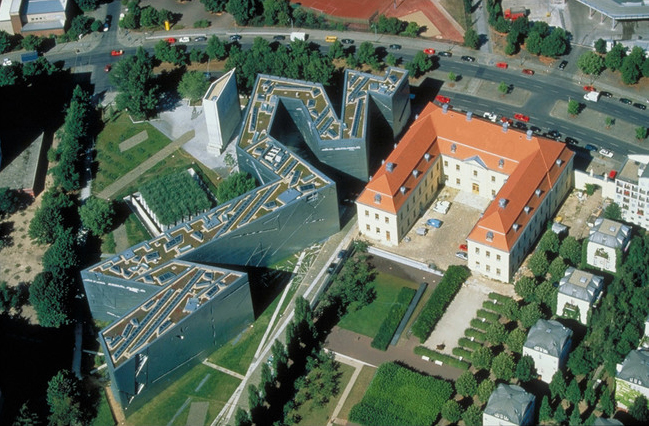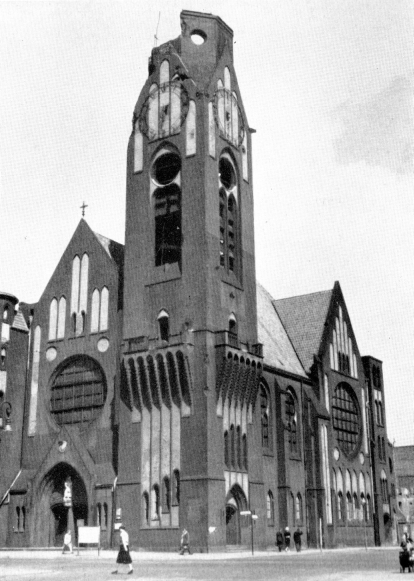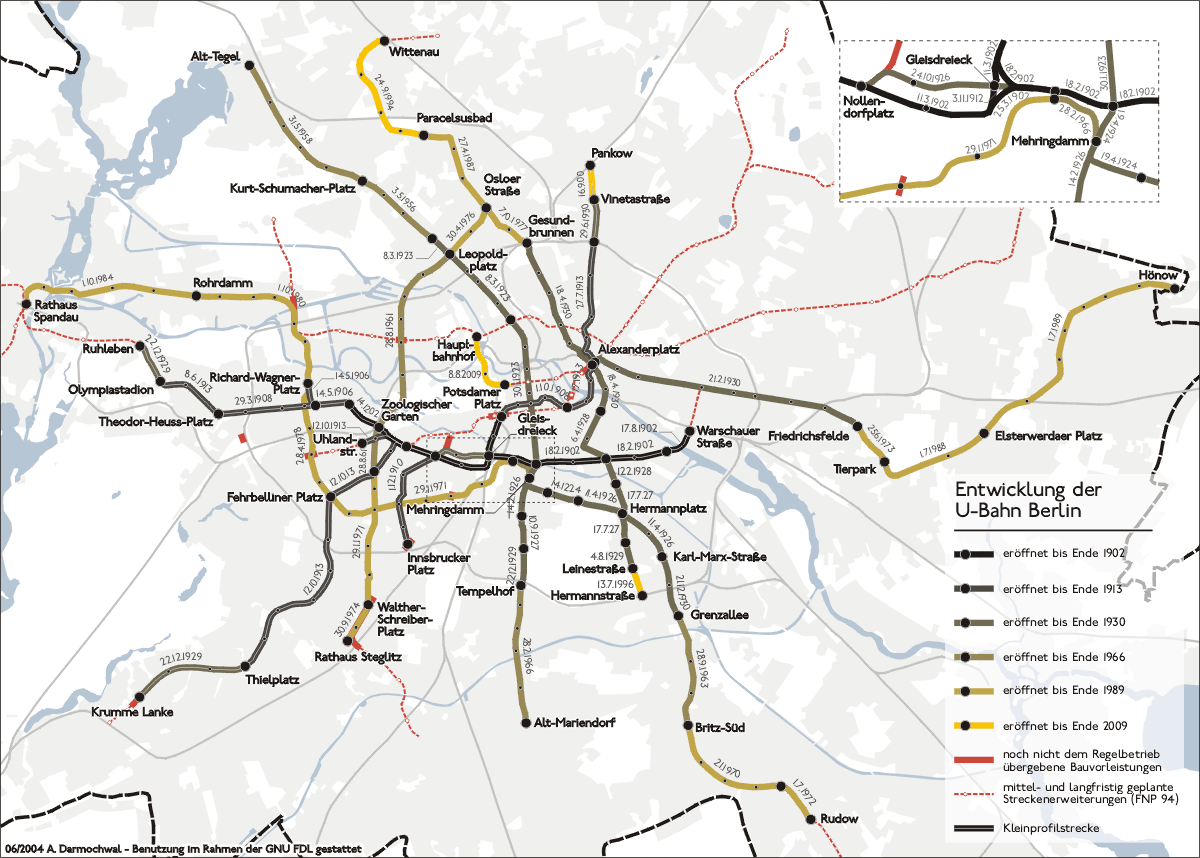|
Hallesches Tor (Berlin U-Bahn)
Hallesches Tor is a Berlin U-Bahn station in the central Kreuzberg quarter, served by lines U1 (Berlin), U1, U3 (Berlin), U3, and U6 (Berlin), U6. It is named after the historic ''Hallsches Tor'' (Halle (Saale), Halle Gate) of the Berlin Customs Wall, erected in the 18th century. Overview The historic gate of the Customs Wall, laid out from 1737 onwards to replace the medieval city fortifications, marked the southern tip of the Friedrichstadt (Berlin), Friedrichstadt neighbourhood. It was located at the southern end of Friedrichstraße and the ''Rondell'' (renamed ''La Belle Alliance, Belle-Alliance-Platz'' in 1815 and Mehringplatz in 1946). Neighbouring gates were on Potsdamer Platz in the west and on Wassertorplatz (Water Gate) in the east, where the present course of the U1 viaduct roughly corresponds to the former city wall. South of the gate, a wooden bridge led across the Landwehr Canal; from here the road ran via Tempelhof to the city of Halle, part of Brandenburg-Prussi ... [...More Info...] [...Related Items...] OR: [Wikipedia] [Google] [Baidu] |
Kreuzberg
Kreuzberg () is a district of Berlin, Germany. It is part of the Friedrichshain-Kreuzberg borough located south of Berlin-Mitte, Mitte. During the Cold War era, it was one of the poorest areas of West Berlin, but since German reunification in 1990, it has undergone significant gentrification and is now known for its vibrant arts scene. The borough is known for its large percentage of immigrants and descendants of immigrants, many of whom are of Turks in Germany, Turkish ancestry. This influx began in the 1960s and 1970s when West Germany invited 'Gastarbeiter' (guest workers) from various countries, including Turkey, Italy, Greece, and Yugoslavia, to address labour shortages and aid in Reconstruction of Germany, post-war reconstruction. As of 2006, 31.6% of Kreuzberg's inhabitants did not have German citizenship. Kreuzberg is known for its diverse cultural life and experimental alternative lifestyles, making it an attractive area for many. However, some parts of the district ar ... [...More Info...] [...Related Items...] OR: [Wikipedia] [Google] [Baidu] |
Wassertorplatz
The Wassertorplatz in the Berlin district of Kreuzberg is named after the historic ''Wassertor'' and is located about 200 meters west of the Kottbusser Tor (Berlin U-Bahn), Kottbusser Tor. The place is currently divided by the heavily frequented Skalitzer Straße and the subway line U1 (Berlin U-Bahn), U1, which runs over the middle strip of Skalitzer Straße as a raised railway. History The square is named after the historic no longer existing water gate which was built during the 1848–1852 construction of the Luisenstadt Canal (''Luisenstädtischer Kanal''). The gate was located in the southeastern area of the Berlin Customs Wall, built in the 18th century, between Hallesches Tor and Kottbusser Tor. Ships entering the city on the canal had to check their goods and clear customs at the lockable gate in the form of an iron grate. Within the customs and excise wall, the canal expanded directly at the water gate to form the Thorbecken or Wassertorbecken. The customs and excise ... [...More Info...] [...Related Items...] OR: [Wikipedia] [Google] [Baidu] |
U1 (Berlin U-Bahn) Stations
U1, U.I or U-1 may refer to: People and characters *Yuvan Shankar Raja (stage name: U1; born 1979), a Tamil musician and film composer *U-1, a fictional character, the protagonist of the ''Gitaroo Man'' video game Computing and electronics *U1, a Secure Digital#Speed class rating, speed class for Secure Digital (SD) cards *Apple U1, a mobile system-on-a-chip *''Ultima I: The First Age of Darkness'', a 1981 video game *U1 Technology, a video game publisher Military *U-1, the 1924 United States Army Air Service aircraft designation system, USAF and 1962 United States Tri-Service aircraft designation system, US Military's designation for the De Havilland Canada DHC-3 Otter light transport aircraft *U-1, Soviet Union military aircraft designation systems, Soviet designation for Avro 504 trainer *Multiple German U-boats named German submarine U-1, ''U-1'' *Oberursel U.I, an early German aircraft engine *HDMS U-1, a Danish submarine *SM U-1 (Austria-Hungary), SM U-1, an Austro-Hungarian ... [...More Info...] [...Related Items...] OR: [Wikipedia] [Google] [Baidu] |
Daniel Libeskind
Daniel Libeskind (born May 12, 1946) is a Polish–American architect, artist, professor and set designer. Libeskind founded Studio Daniel Libeskind in 1989 with his wife, Nina, and is its principal design architect. He is known for the design and completion of the Jewish Museum Berlin, Jewish Museum in Berlin, Germany, that opened in 2001. On February 27, 2003, Libeskind received further international attention after he won the competition to be the master plan architect for the World Trade Center (2001–present), reconstruction of the World Trade Center site in Lower Manhattan. Other buildings that he is known for include the extension to the Denver Art Museum in the United States, the Grand Canal Theatre in Dublin, the Imperial War Museum North in Greater Manchester, England, the Michael Lee-Chin Crystal at the Royal Ontario Museum in Toronto, Canada, the Felix Nussbaum Haus in Osnabrück, Germany, the Danish Jewish Museum in Copenhagen, Denmark, Reflections at Keppel Bay, R ... [...More Info...] [...Related Items...] OR: [Wikipedia] [Google] [Baidu] |
Jewish Museum Berlin
The Jewish Museum Berlin (''Jüdisches Museum Berlin'') was opened in 2001 and is the largest Jewish museum in Europe. On of floor space, the museum presents the history of the Jews in Germany from the Middle Ages to the present day, with new focuses and new scenography. It consists of three buildings, two of which are new additions specifically built for the museum by architect Daniel Libeskind. German-Jewish history is documented in the collections, the library and the archive, and is reflected in the museum's program of events. From its opening in 2001 to December 2017, the museum had over eleven million visitors and is one of the most visited museums in Germany. Opposite the building ensemble, the W. Michael Blumenthal Academy of the Jewish Museum Berlin was built – also after a design by Libeskind – in 2011/2012 in the former flower market hall. The archives, library, museum education department, a lecture hall and the Diaspora Garden can all be found in the academy. H ... [...More Info...] [...Related Items...] OR: [Wikipedia] [Google] [Baidu] |
Amerika-Gedenkbibliothek
The Amerika-Gedenkbibliothek (AGB; ) is one of the largest public libraries in Berlin, Germany. It was co-financed by a donation from the United States. The building was designed by American and German architects, including Fritz Bornemann and Willy Kreuer. It was opened on September 17, 1954, and was originally planned to become the Central Library of Berlin. History In 1950 the American people had donated $5 million (=Deutsche Mark, DM 21 million; so-called John J. McCloy, McCloy Grant) for cultural purposes in recognition of the West Berliners' keeping up during the Berlin Blockade, which took place in 1948/1949. With DM 5.4 million (=$1.285 million) from the grant, and additionally the same sum from its own funds, the Senate of Berlin built the new library on Blücherplatz in Kreuzberg. On 10 September 1954 it opened to become Berlin's central public library.Frauke Mahrt-Thomsen, ''150 Jahre: Von den Berliner Volksbibliotheken zur Stadtbibliothek Kreuzberg; eine Chronik'', Bez ... [...More Info...] [...Related Items...] OR: [Wikipedia] [Google] [Baidu] |
Bombing Of Berlin In World War II
Berlin, the capital of Germany, was subject to 363 air raids during the Second World War. It was bombed by the RAF Bomber Command between 1940 and 1945, the United States Army Air Forces' Eighth Air Force between 1943 and 1945, and the French Air Force in 1940 and between 1944 and 1945 as part of the Allied campaign of strategic bombing of Germany. It was also attacked by aircraft of the Red Air Force in 1941 and particularly in 1945, as Soviet forces closed on the city. British bombers dropped 45,517 of bombs, while American aircraft dropped 22,090.3 . As the bombings continued, more and more people fled the city. By May 1945, 1.7million people (40% of the population) had fled. Prelude When the Second World War began in 1939, US President Franklin D. Roosevelt issued a request to the major belligerents to confine their air raids to military targets. The French and the British agreed to abide by the request "upon the understanding that these same rules of warfare will be sc ... [...More Info...] [...Related Items...] OR: [Wikipedia] [Google] [Baidu] |
Berlin Potsdamer Platz Station
Berlin Potsdamer Platz is a railway station in Berlin. It is completely underground and situated under Potsdamer Platz in central Berlin. Regional and S-Bahn services call at the station, and it is also served by U-Bahn line U2. History S-Bahn The first station at Potsdamer Platz was the Potsdamer Bahnhof terminus, which was closed on 27 September 1945 due to war damage. In 1939 the S-Bahn, or ''Stadtbahn'' (City Railway), arrived. The idea for a North-South Link rapid transit rail line from Unter den Linden to Yorckstraße, via Potsdamer Platz and Anhalter Bahnhof, had first been mooted in 1914, but it was not planned in detail until 1928, and then approval had to wait until 1933. Begun in 1934, it was plagued with disasters. Determination to have it finished in time for the Berlin Olympic Games in 1936 meant vital safety measures were ignored: on 20 August 1935, a tunnel collapse just south of the Brandenburg Gate buried 23 workmen of whom only four survive ... [...More Info...] [...Related Items...] OR: [Wikipedia] [Google] [Baidu] |
Stralauer Tor (Berlin U-Bahn)
Stralauer Tor (''Osthafen'' as of 1924) was a Berlin U-Bahn station in Berlin-Friedrichshain. It operated between Warschauer Straße and Schlesisches Tor stations on today's U1. Following its destruction in World War II it was never rebuilt and is one of three Berlin U-Bahn stations (the others being Nürnberger Platz, which was closed and demolished in 1961 and Französische Straße, which was closed in 2020) to have been abandoned after having previously been in service. History ''Stralauer Tor'' was an elevated station built into the north-eastern part of the viaduct, which featured a barrel-shaped roof and two street level stairwell entrances accommodating opposing platform sides.berliner-untergrundbahn.de ''Berlins U-Bahnstrecken'' It was constructed by German engineering company |
History Of The Berlin U-Bahn
The Berlin U-Bahn originated in 1880 with Werner von Siemens, Werner Siemens' idea to build an urban railway in Berlin. During the nine years after the German Empire was founded, the city's population grew by over one-third and traffic problems increased. In 1896, Siemens & Halske began to construct the first stretch of overhead railway. On 1 April 1897, the company began construction of an electric underground railway. The Berliner Verkehrs Aktiengesellschaft (BVG) was formed in 1928, and took over further construction and operation of the network. In 1938, the company was renamed Berliner Verkehrsbetriebe, Berlin Transport Company; the original acronym, however, remained. Since 1994, the BVG has been a public company. The line between Stralauer Tor (Berlin U-Bahn), Stralauer Tor and Berlin Potsdamer Platz station, Potsdamer Platz (the present-day U1 (Berlin U-Bahn), U1 line) was the first to open, on 18 February 1902. Four additional lines were built before the World War I, Fir ... [...More Info...] [...Related Items...] OR: [Wikipedia] [Google] [Baidu] |
Elevated Railway
An elevated railway or elevated train (also known as an el train or el for short) is a railway with the Track (rail transport), tracks above street level on a viaduct or other elevated structure (usually constructed from steel, cast iron, concrete, or bricks). The railway may be a Broad-gauge railway, broad-gauge, Standard-gauge railway, standard-gauge or Narrow-gauge railway, narrow-gauge railway, light rail, monorail, or a suspension railway. Elevated railways are normally found in urban areas that would otherwise require impracticably many level crossings. Usually, the tracks of elevated railways that run on steel viaducts can be seen from street level. History The earliest elevated railway was the London and Greenwich Railway on a London Bridge-Greenwich Railway Viaduct, brick viaduct of 878 arches, built between 1836 and 1838. The first of the London and Blackwall Railway (1840) was also built on a viaduct. During the 1840s there were other plans for elevated railways in L ... [...More Info...] [...Related Items...] OR: [Wikipedia] [Google] [Baidu] |





